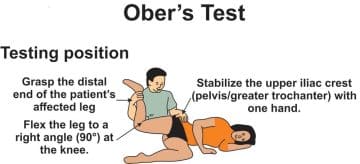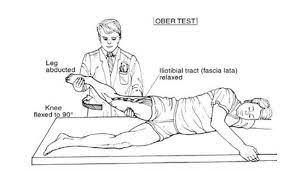Is the upper part of your thighs hurting you or feeling uncomfortably tight and you wanna know the kind of test that will be performed on you by the doctors when you go for testing in the hospital?
If yes, then you are on the right site, because today, Healthsoothe will elaborate on all there is to know about the test that is done to evaluate what causes the uncomfortable pains you are experiencing in your upper thighs. The test that is usually done to assess this is known as the ober’s test.
Ober test is usually used by doctors in hospitals to evaluate tight, contracted, or inflamed iliotibial band (ITB) and tensor fasciae latae (TFL) which usually cause pain to the person experiencing them. The ITB and TFL help in the movements of the leg.
Proceeding on.
Ober Test – What is it?

The Ober’s test that is usually used by doctors in hospitals to evaluate tight contracted, or inflamed iliotibial band (ITB) and tensor fasciae latae (TFL) which usually cause pain to the person experiencing them. The ITB and TFL help in the movements of the leg.[mfn]wikipedia[/mfn].
The Ober test assesses tightness in the tensor fascia latae muscle which is responsible for a tight iliotibial band. During the test, the patient lies on his/her side with the unaffected leg on the bottom with their shoulder and pelvis in line. The lower hip and knee can be in a flexed position to take out any lordosis of the lumbar spine.
To perform this test, have your patient in a side-lying position, with the lower leg in flexion at the hip and the knee for stability. Then, the examiner passively abducts the upper leg and brings it into slight extension, while the other hand fixates the pelvis.
In literature, this test was first described in 90° of knee flexion but we prefer to have the upper leg completely extended to have the iliotibial band under even more stretch. Then, slowly lower the upper leg all the way down to the table.
This test would be positive if the upper leg stays in the air and does not fall down on the table, which is not the case here. No studies support the validity of the Ober test for measuring iliotibial band tightness.
You can watch the video below to know more:
The Function or Purpose of the Ober’s Test
Obers test determines if the tensor fasciae latae (TFL) and the iliotibial band are tight, constricted, or inflammatory (ITB). The Ober’s test should not be confused with Noble’s and Renne’s tests, which are also often used to identify iliotibial band syndrome.[mfn]physiotutors[/mfn]
Ober test determines if the tensor fasciae latae (TFL) and the iliotibial band are tight, constricted, or inflammatory (ITB). The Ober’s test should not be confused with Noble’s and Renne’s tests, which are also often used to identify iliotibial band syndrome.
How the Ober Test is Done – Procedures for Performing the Ober’s Test

Steps for performing the test
With the patient lying in the lateral position, support the knee and flex it to 90 degrees. Then abduct and extend the hip. Then release the knee support. Failure of the knee to adduct is a positive test.
The examiner places a stabilizing hand on the patient’s upper iliac crest and then lifts the upper leg, flexed at the knee, extends it at the hip, and slowly lowers it toward the bottom leg, allowing the thigh to lower towards the table. The examiner must continue to stabilize at the hip to ensure there is no movement. The test result is positive if the patient is unable to adduct the leg parallel to the table in a neutral position.
The technique of the Ober Test
Frank Ober described the TFL and ITB tightness test in his paper “Back Strain and Sciatica,” where he explored the association between a constricted TFL and ITB and low backache. This was amended in 1937 to advise against hip internal rotation and flexion when performing the test.
Test Positioning
- The patient should be side-lying with the afflicted side up throughout the test.
- To flatten the lumbar curvature, bend the bottom knee and hip.
- To prevent movement in either direction, stand behind the patient and firmly hold the pelvis/greater trochanter.
- With your other hand, grasp the distal end of the patient’s injured leg and bend it to a right angle at the knee.
The Ober’s Test
- Extend and abduct the hip joint to perform the test.
- Lower the leg toward the table, adducting the hip, until mobility is limited.
- During the test, ensure that the hip doesn’t internally twist and flex, and that the pelvis is stable. Allowing the thigh to dip in flexion and internal rotation would ‘give in’ to the tight TFL and result in an inaccurate length measurement.
Results of the Ober Test
- If the ITB is tight, the leg will stay abducted and the patient will have lateral knee discomfort; the test is considered positive in this situation.
- If the ITB is sound, the leg will adduct with the thigh dipping slightly underneath the horizontal and the patient will not feel any discomfort; this is referred to as a negative test.
Ober Modified Test
It was initially advocated that there is a variation of the Ober test in Posture and Pain. There is less pressure on the medial portion of the knee joint, less tension on the patella, less hindrance from a tight Rectus Femoris, and a full stretch on the TFL in this test.
Position of testing
- The patient is laying on his side, with his lower leg flexed at the hip and knee to flatten his low back.
- The examiner maintains the pelvis stable and the lateral trunk in touch with the table.
N/B: Downward lateral tilt is equal to hip abduction, which would “cause” a tight TFL.
The Test
The examiner raises the leg. Check that the limb is not internally rotated.
Results
The thigh lowers roughly 10 degrees below the horizontal when the knee is straight and the pelvis is neutral. It suggests a typical length. The inability of the leg to descend implies stiffness of the ITB and TFL.
Does the Ober Test Have Any Side Effects?
No, the ober test has not been observed to have any side effects as it’s not an invasive test. The only problems seen with the ober’s test are just the inaccuracies or inconsistencies associated with it, because if it isn’t done properly, it leads to false results.
Other Tests like the Ober’s Test
- Thomas Test
- Ely’s Test
- Kendall Test
- 90-90 Straight Leg Raise Test
- Backsaver Sit and Reach Test
- Tripod Sign
- Phelp’s Test
Evidence Concerning the Ober’s Test
The validity of this test is supported by a small amount of research. According to research by Reese et al, utilizing an inclinometer to quantify hip adduction adopting both the Ober test as well as the modified Ober test seems to be a valid way of measuring IT band flexibility, and the procedure is relatively simple.
It found a substantial difference in ROM when testing with the afflicted knee flexed vs extended, with reliability values of.90 and.91, respectively. The modified Ober test has a substantially higher hip adduction range of movement than the Ober test; nonetheless, the testing protocols should not be utilized interchangeably for determining IT band flexibility.
However, the results of Willet GM et al’s research; ‘An Anatomic Investigation of the Ober Test’ reject the concept that the ITB plays a role in restricting hip adduction during both versions of the Ober test and call into doubt the usefulness of these tests for evaluating ITB tightness.
The findings highlight the importance of the gluteus medius and minimus muscles, as well as the hip joint capsule, in determining Ober test results. According to the findings of this research, the Ober test measures the tightness of tissues close to the hip joint, like the gluteus minimus and medius muscles and the hip joint capsule, rather than the ITB.
Key Research about the Obers Test
Gajdosik RL et al reported in Clinical Biomechanics that hip adduction movement was limited more with the knee flexed than when the knee extends in both genders (P 0.009). Thus, stressing the impact of knee position and gender on the Ober test for iliotibial band length.
A Postural Restoration Institute exercise to activate hamstrings and abdominal muscles revealed a substantial improvement in passive hip-adduction angles (p0.01) and a reduction in pain (p0.01), instantly improving Ober’s Test measures in persons with lumbopelvic discomfort.
The research found that hamstring/abdominal activation, instead of an iliotibial band stretching, might be an effective treatment for lumbopelvic discomfort and a positive Ober Test.
The research investigates the impact of ITB stretching, Hamstring, and Abdominal activation, and a positive Ober test on those suffering from lumbopelvic discomfort. When compared to simple ITB stretching, hamstring and abdominal activation resulted in a larger reduction in discomfort and an increase in hip adduction.
Final Words from Healthsoothe
According to a study by Willett et al. (2016), they “refute the hypothesis that the ITB plays a role in limiting hip adduction during either version of the Ober test and question the validity of these tests for determining ITB tightness.
The findings underscore the influence of the gluteus medius and minimus muscles as well as the hip joint capsule on Ober test findings.” So be careful with your interpretation!


